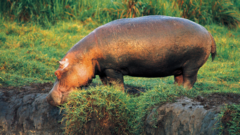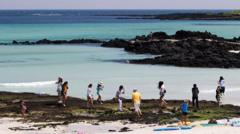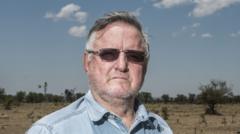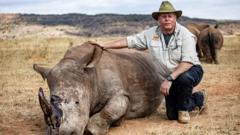Recent reports indicate significant wildlife fatalities due to anthrax exposure in Africa's oldest national park.
Tragic Anthrax Outbreak Claims Lives of 50 Hippos in DR Congo National Park

Tragic Anthrax Outbreak Claims Lives of 50 Hippos in DR Congo National Park
A deadly anthrax outbreak threatens wildlife in Virunga National Park.
Fifty hippos and several other large animals have recently succumbed to a devastating anthrax outbreak in Virunga National Park, located in the Democratic Republic of Congo. This news comes from the park's director, Emmanuel de Merode, who has confirmed the testing for anthrax following the grim discovery of these animals floating lifeless along the Ishasha River. The troubling trend began to emerge last week, though the specific circumstances leading to the outbreak remain unclear.
In response to the situation, park officials are working to retrieve and properly dispose of the deceased animals to mitigate the risk of further spread. However, de Merode highlighted logistical challenges, citing the lack of excavators and difficult access points within the park. To combat the potential risks posed by the contaminated animals, they plan to use caustic soda for burial.
The Ishasha River flows into Lake Edward, where additional reports of dead wildlife have surfaced. It's important to note that anthrax, caused by Bacillus anthracis, can be lethal, yet it typically does not transfer easily between animals. It primarily exists in spore form within the environment, lying dormant in soil and reactivating when animals inhale or come into contact with it through wounds.
The Congolese Institute for the Conservation of Nature has issued warnings to local residents, advising them to steer clear of wildlife and to ensure that they boil their water before consumption in light of this outbreak. Virunga National Park spans an expansive 7,800 square kilometers and is home to incredible biodiversity, including one-third of the world's remaining mountain gorillas. However, it is also known for its perilous conditions due to ongoing conflicts involving various rebel factions and the Congolese military.
The park has faced a decrease in its hippo population from over 20,000 to a paltry few hundred in recent decades, largely a result of poaching and warfare, but conservation efforts have aimed to improve their numbers. The situation in Virunga remains dire as both wildlife and rangers face threats in their continuous battle for survival amidst instability.
In response to the situation, park officials are working to retrieve and properly dispose of the deceased animals to mitigate the risk of further spread. However, de Merode highlighted logistical challenges, citing the lack of excavators and difficult access points within the park. To combat the potential risks posed by the contaminated animals, they plan to use caustic soda for burial.
The Ishasha River flows into Lake Edward, where additional reports of dead wildlife have surfaced. It's important to note that anthrax, caused by Bacillus anthracis, can be lethal, yet it typically does not transfer easily between animals. It primarily exists in spore form within the environment, lying dormant in soil and reactivating when animals inhale or come into contact with it through wounds.
The Congolese Institute for the Conservation of Nature has issued warnings to local residents, advising them to steer clear of wildlife and to ensure that they boil their water before consumption in light of this outbreak. Virunga National Park spans an expansive 7,800 square kilometers and is home to incredible biodiversity, including one-third of the world's remaining mountain gorillas. However, it is also known for its perilous conditions due to ongoing conflicts involving various rebel factions and the Congolese military.
The park has faced a decrease in its hippo population from over 20,000 to a paltry few hundred in recent decades, largely a result of poaching and warfare, but conservation efforts have aimed to improve their numbers. The situation in Virunga remains dire as both wildlife and rangers face threats in their continuous battle for survival amidst instability.
















